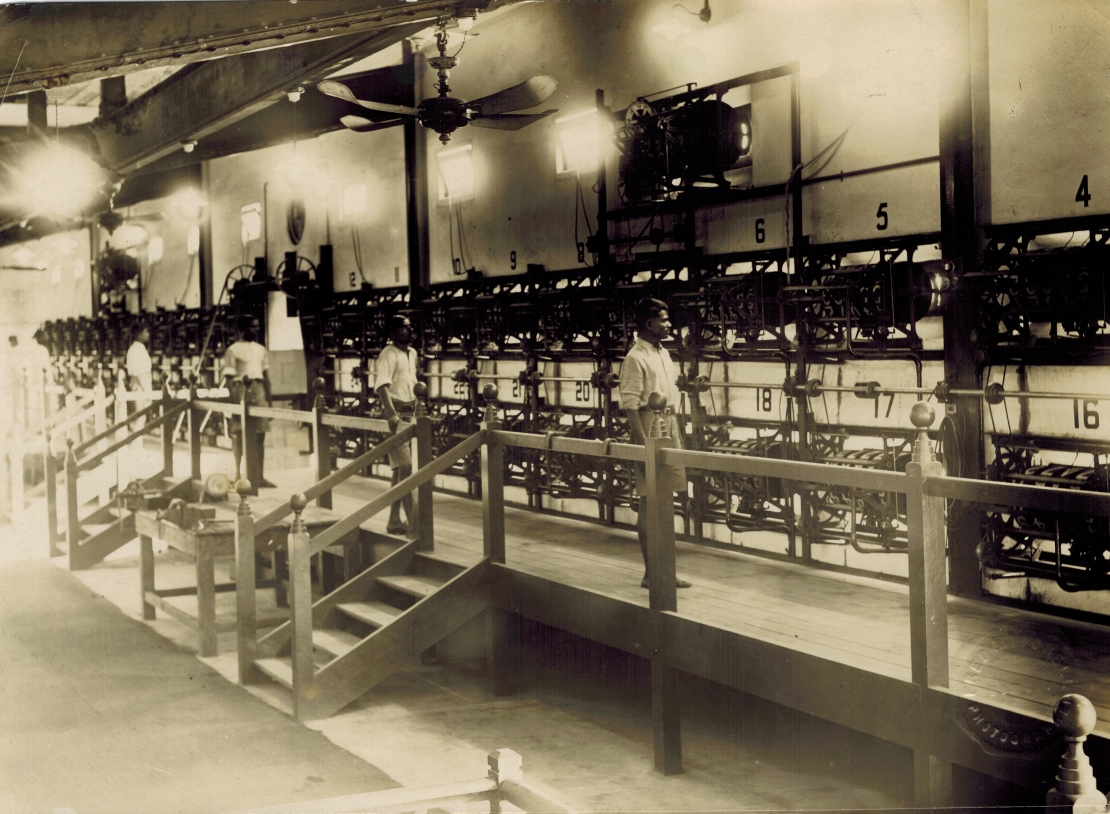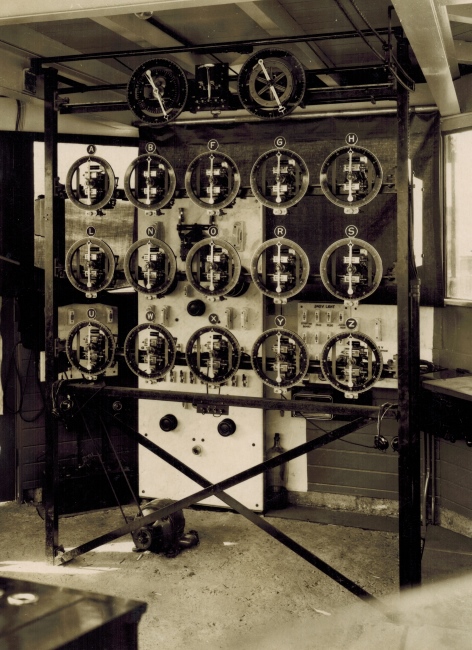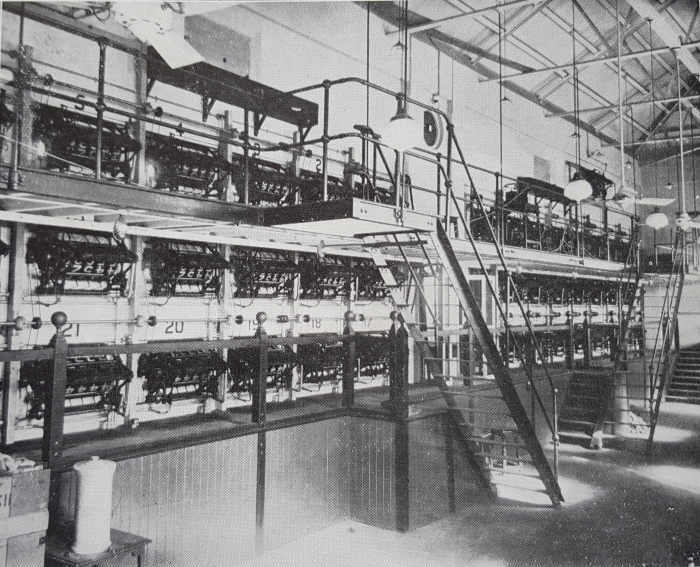More after the image...

Click on the image to go back to the Photo Gallery
If you arrived from navigating the website, use the navigation bar at the bottom of this page.
The photographer's stamp on this photo reads FRED MITCHELL PHOTOGRAPHER BOMBAY
Copyright © 2014 Email - totehis@hotmail.com
More after the image...

The photographer's stamp on this photo reads FRED MITCHELL PHOTOGRAPHER BOMBAY
This Julius Totalisator in Bombay, became the largest automatic totalisator in the world in 1926, winning the title from the Julius Totalisator at Randwick Racecourse in Sydney.
Following is a 1925 Referee newspaper article titled OFF TO INDIA which records Frederick Wilkinson's departure to Bombay in October 1925, extracted from the Trove newspaper archive on the Internet. Frederick was a prominent Automatic Totalisators Limited manager who started as a design engineer working on ticket issuing machines and later became the State Tote Manager of Automatic Totalisators Limited. He worked for the company for 30 years and participated in several of the company's overseas projects like this one. As State Tote Manager he would have spent much of his time at Randwick Racecourse, particularly as Automatic Totalisators Limited had an office at Randwick Racecourse:
Citation: 1925 'OFF TO INDIA.', Referee (Sydney, NSW : 1886 - 1939), 21 October, p. 3. , viewed 11 Feb 2017, http://nla.gov.au/nla.news-article127572003
It is interesting to note that the author of this 1925 article comments about the lack of a Julius totalisator at Longchamps. Rudolph Wilkinson, in relating that Frederick also worked on the Longchamps project almost answers this comment as it shows a Julius tote later was installed at Longchamps.OFF TO INDIA.
Mr. F. A. Wilkinson, manager of the Automatic Totalisator Ltd., leaves for India to-day. His trip is for the purpose of supervising the completion of the Totalisators which are being installed at Bombay.
It surprises me that the Automatic Tote's machines have not been adopted in France. Totalisator arrangements at Longchamps, where the Grand Prix is run, are very poor by comparison with those of Randwick.
Rudolph F. Wilkinson, the son of Frederick Augustus Wilkinson wrote that Frederick also worked on the French project involving racecourses in France, notably Longchamps and that he actually lived in Paris for four and a half years whilst working on this project.
Following is a second National Library of Australia Trove newspaper archive article, which relates an annual shareholders meeting of Automatic Totalisators Ltd in December 1925, in which the Bombay Tote is referred to as, one of the largest in the world. It also mentions that the Bombay Julius totalisator operated the prior Saturday for the very first time. I have added the bold emphasis.
Citation: 1925 'AUTOMATIC TOTALISATORS LTD.', The Brisbane Courier (Qld. : 1864 - 1933), 21 December, p. 4, viewed 21 May, 2015, http://nla.gov.au/nla.news-article20987749
AUTOMATIC TOTALISATORS LTD.
At the annual meeting of shareholders of Automatic Totalisators Ltd., at Sydney on Wednesday last, the chairman, Mr. E. H. Buchanan, referred to the company's installations at the opening of Olympia Motor Speedway. The installations are an automatic starting machine, an indicator, and a race-timing machine. He also mentioned the fact that the company's totalisator at Bombay (India), one of the largest in the world, was used for the first time on Saturday last. It was announced that dividends would be payable on December 31. The report and balance-sheet were adopted, and Mr. F. W. Marks was re-elected a director. Messrs. M Donald, Witt, and Co., auditors, were reappointed.
Following is a third extract from a Trove newspaper article, which was written over a year later than the ones above and states that Bombay is the largest automatic Totalisator in the world. If you base the size of a totalisator on the number of terminals it has, the Bombay system has become the largest in the world due to the installation of an additional 50 terminals in 1926 which brings the total up to 176 which exceeds the previous largest tote which was at Randwick with 150 terminals. This installation information has been extracted from a table titled Timelines - The Premier (Julius) totalisator in the Installations Testimonials - The Premier Totalisator chapter of this website. To read this, select the Go to the index button in the Navigation bar at the bottom of this page and then select the chapter just mentioned in the Firstly section of the index.
The subject of the article from which the following is extracted, is the Automatic Totalisators Ltd. installation at Longchamps in France.
Citation: 1927 'World's Biggest Tote.', The Midlands Advertiser (Moora, WA : 1907 - 1930), 1 April, p. 4, viewed 21 May, 2015, http://nla.gov.au/nla.news-article156985282:
Bombay at present has the largest automatic totalisator in the world supplied by the Australian, firm and it is learned that the Longchamps one will be at least three times the size of Indian one.I used to wonder what criteria were used in the days of these initial networked systems to gauge the size of a totalisator. Nowadays one obvious basis for comparison is the number of terminals it supports and this does align with the choice of the world's largest totalisator, but not the magnitude of the difference with the predecessor, as expressed in newspaper articles. On the basis of number of terminals, I see no reason for the claim in the article extract above that the Longchamps system will be at least three times the size of the Indian one. In a Referee newspaper article from 20th May 1937 titled World's Biggest Tote Ready Next Month relating to the White City London Julius Totalisator, which claims the White City Julius totalisator will be three times the size of the Longchamps Julius totalisator, it seems to be comparing costs which include that of the buildings to be constructed to house the totalisator systems. What is it in these articles about three times the size? According to a Moora West Australia newspaper article the Longchamps Julius Tote will be three times the size of the Bombay Julius Tote and from a Sydney New South Wales newspaper, the White City Julius totalisator will be three times the size of the Longchamps Julius totalisator.
Although the above article recognises the largest automatic totalisator in the world as being the Julius totalisator in Bombay in 1927, this system will not hold this title for long. This system actually became the largest automatic totalisator in the world in 1926 based on the number of terminals as mentioned previously. The 1927 newspaper article extract above already refers to the Longchamps Julius totalisator, which later snatched this title when it commenced operation in 1928 with 273 terminals. The Longchamps system will in turn loose this title to the later Julius totalisator in White City London that ended up with 320 terminals, which is the largest Julius Tote system I am aware of.
Note that the staff seen in the image above seem to be set up for maintenance work. There is a workbench in between the closest two short stairways. It is set up with two vices attached to the left side of the bench and what looks like it might be a grinding wheel attached to the far side of the bench. On one hand the scene in the above image seems very familiar to me, yet there is much that is different to my experience of it. I worked on the hardware maintenance of totalisator systems during the digital minicomputer era, so this scene with attending operational/technical staff is familiar, particularly so the workbench.
In my time in the industry the workbenches were very different however. It was an era when digital computers were much more hardware intensive and consequently large, far more expensive and much less reliable than what we are used to nowadays. Our workbenches had a Tektronix 465 CRO (Cathode Ray Oscilloscope) as well as a Multi-meter and a Weller temperature controlled soldering station with a roll of solder on top of them. They also had a sizeable cupboard full of circuit and block diagrams and other technical drawings, circuit description/maintenance manuals and diagnostic description and listing manuals. Our workbenches had drawers, that amongst other things contained a supply of particularly prone to failure integrated circuits. We had a base which had an extensive store of spare electronic components.
Our benches always had a toolbox either under the bench or nearby and I suspect there will be a toolbox not far from the workbench in the image above. Possibly it has been hidden away for the sake of a tidy machine room look for the photo. I suspect that the primary tools in that toolbox will probably be a hammer, chisel, and a variety of spanners screwdrivers and pairs of pliers and the all important lubricating oil can for all those moving mechanical parts that the Julius Totes were all about. The primary tools in ours were a solder sucker, a couple of adjustable spanners, a pair of light wire cutters, bull nosed and long nosed pliers, a screwdriver set as well as a set of watchmaker screwdrivers. We had a small light machine oil bottle that was mainly used for oiling the bearings in the odd noisy equipment cooling fan.
I will also make a comment about the apparent inactivity of the staff in the image above. I do not know if the photograph was taken during an actual race meeting, or a trial run, or if it is just a posed photo. What I do know is that with the Julius Tote there was a lot of activity between races requiring a stop betting procedure, the recording of pertinent information from the machinery, using that information to manually calculate the dividends and authorise payment, followed by the significant job of resetting all the machinery to make it ready for the next race and finally starting the betting again. Additionally, if you see a system from my era, where the engineers are seen racing around in a mad panic every meeting due to the large amounts of problems, then you are probably seeing a poorly maintained system in operation. This probably also applies to these old electromechanical systems as well. Finally, unlike the electronic computer era totalisators, both watching and listening to these electromechanical systems in operation were important preemptive procedures. That is probably why the staff in the image above seem so attentive to the equipment.
The other situation resulting in such looks was to do with people who had no knowledge of these systems, who looked on in awe at this at the time never seen before by the public, computational marvel, with all its visual activity and sound. Nowadays computers have become ubiquitous, perform their processing silently and have even become generally integrated with lifestyle.
 The Olympia Motor Speedway Timing Machine
The Olympia Motor Speedway Timing Machine
As a flippant observation, I note that I accessed The Brisbane Courier NLA News Article presented above in 2015, 90 years after the Automatic Totalisators Ltd. shareholder meeting it relates to took place.
It is interesting to note that like the 1917 Randwick Julius Tote, the prior largest automatic totalisator in the world having multiple enclosures containing Julius Tote machine rooms, the Bombay Julius Tote also had more than one enclosure with a machine room. There is a photograph in an Automatic Totalisators Limited document titled THE PREMIER (JULIUS) AUTOMATIC TOTALISATOR, showing a second machine room belonging to the Bombay Julius Tote, as can be seen in the image below.
Another Julius Tote Machine Room at Bombay
Comments and suggestions welcome to
totehis@hotmail.com
The Next page in this website looks at the Longchamps system in France, the next Julius totalisator to hold the title The Largest Automatic Totalisator in the World
The Previous page in this website looks at the Randwick system in Sydney, the previous Julius totalisator to hold the title The Largest Automatic Totalisator in the World
| Previous page | Go to the index | Top of the page | Next page |